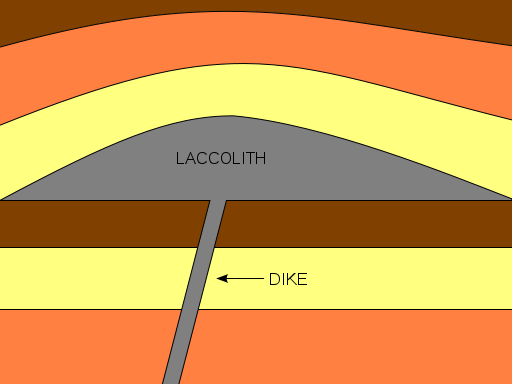 ---> Not all magma makes it to the surface to be extruded, some of it solidifies underground. The igneous rocks formed can contribute to surface geomorphology through uplift, erosion and exposure at the surface.
---> Not all magma makes it to the surface to be extruded, some of it solidifies underground. The igneous rocks formed can contribute to surface geomorphology through uplift, erosion and exposure at the surface. - Rocks get intruded, hotspot of magma underneath, replaces a layer of bedding, therefore is concordant in relation to bedding planes
i.e Whin Sill, Greenland, Palisades

DYKE = discordant (cuts through other bedding planes)
- A vertical intrusion that cuts through bedding planes, therefore discordant in raltion to bedding plane
- Spines of igneous material formed as where dykes cut through bedding rocks surrounding softer rock is easily eroded
i.e Arran dykes

LACCOLITH
- Forms a small upwards, flat-bottomed, dome located within first kilometre of the surface
i.e Montana
BATHOLITH
- slowly cooled igneous rock, greater than 100km2
- produces lots of sandy beaches due to erosion of silica rich granite
- moors very boggy as granite is impermeable to water
- china clay formed by hydrolysis of feldspar within granite
- top of batholith, pressure release cracks, not layers, as weight has been removed
- very popular with climbers and possibilty to exploit geothermal energy = 'Hotrocks' project
i.e Dartmoor to Landsend
VOLCANIC PLUGS
 - Quite a lot of castles are built on old igneous intrusive landforms such as volcanic plugs
- Quite a lot of castles are built on old igneous intrusive landforms such as volcanic plugsi.e Edinburgh
 GIANTS CAUSEWAY/FINGALS CAVE
GIANTS CAUSEWAY/FINGALS CAVE- largest basltic lava flows that cooled slow enough to form columnar rock joints, forming hexagnol shapes. Middle parts cooled very slowly comapred to outside
- Gaps that appear between rock columns means it is vulnerable to freeze haw amongst other weathering processes
- Produces very steep-sided coastlines, cliff roughly on a 85 degree angle


No comments:
Post a Comment